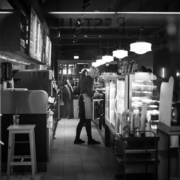Does Street Culture Travel?
Some people may assume that street culture, defined as “the beliefs, dispositions, ideologies, informal rules, practices, styles, symbols, and values associated with, adopted by, and engaged in by individuals and organizations that spend a disproportionate amount of time on the streets of large urban centers” (Ross, 2018, p. 8), or elements thereof, are unique to particular communities, neighborhoods, cities, countries, or regions.
Why might individuals hold this impression? Casual observers, including tourists, often encounter vibrant or unusual street cultures in “hip” places like Williamsburg (New York City), Hackney (London), or Shimokitazawa (Tokyo), or dangerous urban areas (often referred to as ghettos, barrios, favelas or “no go areas”) such as Rocinha, Rio de Janeiro, Scampia, Naples, Tower Hamlets, London. This often leads the bystanders or spectators to believe that the behaviors and dispositions of people that they observe on the street in these locations are unique to these places. For instance, while certain elements of streetwear (e.g., shoes, hats, jackets, etc.) or body modifications (e.g., tattoos, body piercings, etc.) (prominent visual aspects of street culture), may indeed have originated in these areas, it’s inaccurate to suggest that they are exclusive to them.
There are likely three primary reasons why there is considerable dissemination of street culture.
First, individuals in advanced industrialized democracies are relatively mobile. They freely move from one neighborhood, city, county, state, region, or country to another. For instance, people may reside in one part of a urban location, work in another, and spend their leisure time in a completely different area.
Second, in today’s globalized world, individuals are exposed to a plethora of media forms, signs and significations, and diverse information sources. They have the freedom to select, be influenced by, and integrate various cultural elements into their thinking and behavioral repertoires.
Third, when considering streetwear or fashion most people’s clothing choices are often serendipitous rather than the result of conscious decisions. Sure, they might dress according to the occasion, be it work, leisure, or sports, but they may equally simply reach into their drawers or open their closets and select an item that first catches their eye, one that is clean, or that they have not worn for a while.
That being said, there are also numerous examples where selected elements of street culture thought to be generalizable to communities, neighborhoods, etc. worldwide don’t work (or travel well). For example, Elijah Anderson posits that the “Code of the Street” phenomenon (a set of informal rules and expectations governing interpersonal behavior, particularly among residents of inner-city neighborhoods in the United States that includes norms about respect, territoriality, street smarts, and the use of violence) not only applies to the North Philadelphia neighborhood of Sugar Hill, where he did his fieldwork, but to similar neighborhoods around the world. Scholarship by Sebastian Kurtenbach and colleagues, for example, indicates that the code of the street phenomenon is not as universal as Anderson implies.
What are the implications of these observations? It suggests that when conducting research on or making generalizations about street culture, it’s crucial to recognize that what occurs in one neighborhood may or may not happen in others as well. Therefore, findings may not be as unique as initially assumed. Equally important is to understand is what enables or frustrates their dissemination, and who and why they adopt these dispositions and behaviors.
In conclusion, understanding if street culture is special to particular neighborhoods or if we see similar patterns in other communities is important not just for research and understanding purposes, but it could assist in efforts to engage communities, the distribution of scarce resources, policy development, and the implementation of social programs. By acknowledging the mobility of individuals, the influence of media, and the serendipitous nature of human behavior, we can appreciate the interconnectedness of street cultures worldwide.
Photo Credit
Title: Cholo style, originating from Chicanos in the US, can be seen here as adopted by men from Cacos 13, a gang from the La Neza neighbourhood of Mexico City.
Photographer: CC by 2.0











